Brands will be touting activism and web3 to unite 5 billion World Cup fans
The world has changed since the last World Cup, and widespread criticism of host country Qatar’s human rights record continues. Jon Goynshor of VMLY&R Commerce investigates how to approach this complex brand environment.

What is the brand environment like at this year’s Fifa World Cup in Qatar? / Rhett Lewis via Unsplash
A lot has changed since the last Fifa World Cup, over four years ago in Russia, with everything from the Covid-19 pandemic to protests reshaping the landscape. Social justice and technology have accelerated in unprecedented ways.
Also new this year is that the 32-team tournament will be taking place during the holiday season, and in Qatar for the first time. But throughout Fifa’s history, no matter where the event has been played, sponsors have celebrated the beautiful game’s attributes, helping it become the world’s most popular sport.
Given this year’s controversial host country and web3’s impact on the modern fan, a traditional sports sponsorship won’t be enough. Brands need to invest in purpose-driven storytelling, communities, fan engagement and social currency to resonate critically and commercially.
All great campaigns start with authentic storytelling
Brands that stand by their ethical beliefs will be received most favorably. Besides the controversy surrounding Qatar’s selection as the host nation and its anti-LGBTQ+ laws, there have been concerns regarding civil liberties violations in building the infrastructure. After human rights organizations pressured Fifa to improve working conditions, four of the 14 Fifa sponsors (AB InBev/Budweiser, Adidas, Coca-Cola and McDonald’s) and eight of the 32 qualifying teams publicly supported this initiative.
Teams will be wearing their hearts on their sleeves – literally – with 10 of the most influential European countries planning to have their captains wear a OneLove armband. The Danish team’s sportwear sponsor Hummel is making its logo less visible on the jersey, supported by an Amnesty International donation.
Advertisement
Companies must appeal to loyal fan bases across generations and cultures
This allows brands to identify and form relationships with new consumers while enhancing relationships with current ones. With Fifa estimating an audience of 5 billion viewing at least some of the month-long event, authenticity and cultural relevance will count more than ever.
Amnesty International recently released findings of a YouGov survey corroborating the importance of sponsors’ activism, as 84% of World Cup viewers believe Fifa should allocate some World Cup revenue to pay migrant workers.
Campaigns must create deeper experiences beyond viewership
By understanding each fan’s unique journey, marketers can show up in the right place at the right time, with the right experience to create disruptive fan engagement. The World Cup’s entire media ecosystem (from social media platforms to broadcasters, streamers, brands and rightsholders) is a lot more complex compared to 2018.
As further evidence of the need to create a seamless cross-platform fan experience, Nielsen has found that 82% of fans browse social media or use apps during matches. For this reason, Fifa partnered with Roblox to launch Fifa World, a virtual environment, ahead of this year’s World Cup. It will be sponsored by Visa and Adidas, and allow users to interact in social spaces, earn rewards and collect virtual items. This will be the true embodiment of a ‘game within a game’ approach.
Advertisement
Web3 is providing a new social currency driving consumer behavior
As a sign of the times, Fifa named Crypto.com and Algorand as digital currency ecosystem partners. This will support the first Fifa NFTs. In addition, Budweiser partnered with football superstars to encourage fans to find QR codes on social media, at specific locations and on selected products to win exclusive rewards.
Ensure that content and commerce are linked to business and brand objectives
It’s too early to know which sponsors best meet their business objectives. However, there has been some evidence that the controversy surrounding this year’s host city has impacted World Cup sponsorship revenues; they’ve decreased by 16% between 2014 and 2022, according to a GlobalData report. One of the campaigns that hasn’t been received favorably is Qatar Airways’ partnership with UK football luminary David Beckham; the idealized portrayal of the host city contradicts overall public sentiment.
The Fifa sponsorships that will be most disruptive will be purposeful and web3-based. This approach to modern partnership marketing will help brands find new ways to connect with communities, tapping into ever-evolving ecosystems driving social currency, and ultimately leading to long-term growth. Lastly, it will build the right foundation for ideally a less controversial World Cup.
Suggested newsletters for you
Content by The Drum Network member:

VML
VML is a leading creative company that combines brand experience, customer experience, and commerce, creating connected brands to drive growth. VML is celebrated...
Find out more
